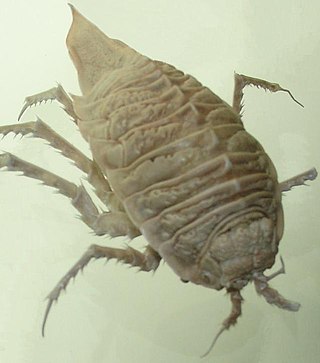
The Valvifera are marine isopod crustaceans. Valviferans are distinguished, however, by the flat, valve-like uropods which hinge laterally and fold inward beneath the rear part of their bodies, covering the pleopods. Some species are omnivorous, and serve as effective scavengers in the economy of the sea.

Sphaeromatidae is a family of isopods, often encountered on rocky shores and in shelf waters in temperate zones. The family includes almost 100 genera and 619 known marine species. Within these genera, there are groups that share distinctive morphologies; further research may reclassify these genus-groups as separate families.
Amphoroidea is a genus of isopod of the family Sphaeromatidae, containing the following species:
Curassanthura is a genus of isopod crustaceans in the family Leptanthuridae. It contains the following species:
Mexilana saluposi is a species of crustacean in the family Cirolanidae, the only species in the genus Mexilana. It is endemic to Mexico.
Onchotelson is a genus of isopod crustaceans in the family Phreatoicidae, which is endemic to Tasmania. It contains two species, both of which are listed as vulnerable on the IUCN Red List:
Ceratoserolis is a genus of isopods in the family Serolidae from the Southern Ocean around Antarctica and some Sub-Antarctic Islands. They prefer to live on soft bottoms and range of least between 24 and 950 m (80–3,120 ft) in depth. They are superficially similar to the unrelated, extinct trilobites and reach up to about 8 cm (3.1 in) in length. They were once considered to be part of the genus Serolis and for a long time only Ceratoserolis trilobitoides was recognized. The validity of the other species has been disputed, but there are some morphological and genetic differences between them and C. trilobitoides, and there are indications that additional, currently unrecognized species of Ceratoserolis exist.
Nichollsia is a genus of isopod crustaceans from India. It comprises two species:
Serolis is a genus of isopod crustacean, containing the following species:
Iais is a genus of isopod crustaceans. Iais species are found in association with larger isopods of the family Sphaeromatidae, usually on the ventral surface of the larger animal, between the pereiopods and on the pleopods. They are native to Australasia and South America, although Iais californica and its host Sphaeroma quoyanum have invaded California, and I. californica was first described from Sausalito, California. Nine species are recognised:

The Idoteidae are a family of isopod crustaceans. It includes these genera:
Remasellus parvus, the swimming Florida cave isopod, is an isopod endemic to 4 caves in the Ochlockonee and Aucilla-Suwanee drainages of Florida, United States. It is the only species in the genus Remasellus.

Paracerceis is a genus of isopod crustacean in the family Sphaeromatidae. It contains the following species:

Gnorimosphaeroma is a genus of isopod crustaceans, containing the following species:
Hemioniscus balani, a species of isopod crustacean, is a widespread parasitic castrator of barnacle in the northern Atlantic Ocean. Its range extends from Norway to the Atlantic coast of France, and as far west as Massachusetts. It is also commonly found on the Pacific coast of North America; it is not known if the Pacific and Atlantic populations are the same species, or if the Pacific population exists following human-assisted introduction.
Sphaeroma terebrans is a mangrove-boring isopod that was first documented in the United States as early as 1897. It is 8–10 millimetres (0.31–0.39 in) long, and is thought to have been introduced by wooden-hulled ships. The isopod is found throughout the Gulf of Mexico mainly in mangrove swamps of Louisiana and Florida. S. terebrans will also bore into boats, wooden pilings and other wooden structures.

The Chaetiliidae are a family of isopod crustaceans in the suborder Valvifera, comprising these genera:

Saduria is a genus of benthic isopod crustaceans in the family Chaetiliidae, containing the following species:

The Entoniscidae are a family of marine isopod crustaceans in the suborder Cymothoida. Members of this family are parasites of brachyuran and anomuran crabs, living in their hosts' haemocoel. A small chitinised hole develops through the host's exoskeleton through which the isopod can communicate with the environment. The female isopod bears little resemblance to any free-living isopod, but the morphology of the larvae show their taxonomic affiliations.
Baicalasellus is a genus of crustaceans in the family Asellidae. It contains the following species:






